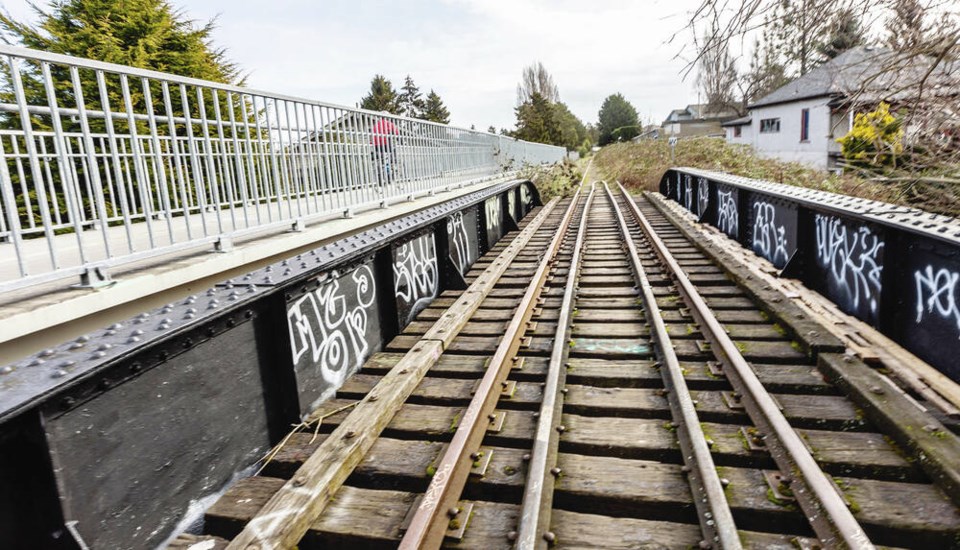A rail service could remove 10,400 to 25,520 truckloads of freight from Island roads every year, says a consultant’s report prepared for the B.C. Transportation Ministry.
Switching freight to rail from trucks would result in estimated annual greenhouse gas emissions savings of 1,741 to 3,636 metric tonnes, HDR Corp. said in its Island Rail Corridor Analysis prepared for the Ministry of Transportation and Infrastructure.
The consultant said a rail service could carry 4,500 to 11,400 annual train-car loads in the near to medium term on the Island corridor, provided that rail shipping and handling fees are competitive with other carriers.
“There are many opportunities for freight rail traffic on Vancouver Island that could be realized with significantly less investment than previous studies have identified,” the December 2022 report says.
B.C.’s Court of Appeal has set a deadline of March 14 for the federal government to decide if it will contribute funds to revive the Island rail service, which last carried passengers in 2011, when it was stopped because of the poor condition of the tracks.
A new rail line would open up opportunities to shift many truck trips over to rail on both Vancouver Island and the Lower Mainland, HDR said in its 49-page report.
It recommended developing a rail connection to Nanaimo’s Duke Point, saying that would deliver benefits to the area and to the corridor.
“Stakeholders agreed that maintaining the Island rail corridor is important to the overall resiliency of the Island, given its limited highway network.”
Its analysis included examining existing services, freight rail demand, potential benefits of shifting freight onto trains, and potential opportunities for businesses to use rail to carry freight along the Island rail corridor’s network.
The company, which has offices in Vancouver and Toronto, interviewed shippers, transportation service providers, industry organizations and port authorities.
Nanaimo Mayor Leonard Krog backs a modern rail service in what he described as one of the fastest-growing regions in the country.
“With respect to the transportation of goods, including utilizing (Port) Alberni’s port facilities, Nanaimo’s port facilities, the rail between, this is very much an integral part of the future of Vancouver Island.”
HDR’s report said the rail system could provide an alternative for moving passengers and freight in the event of road disruptions due to severe weather.
In the longer term, services offering containers and trailers on rail flatcars could cut back on truck traffic on highways, it said. Trailer and container flatcars could run to marine terminals such as Duke Point, Courtenay or Port Alberni.
The study said the greatest potential for growth of freight rail is from industries in the central part of the corridor — from Duncan to Parksville — and in Port Alberni.
More freight could be lured from other types of transportation provided rail service was faster, frequent and cost-competitive with trucking, it said.
There is a significant opportunity to load lumber on the Island rail corridor network and to move wood chips from sawmills to pulp and paper mills on the Island, it said. Today, about half the wood chips used by pulp and paper mills arrive on trucks.
The pulp and paper sector — historically a major user of rail on the Island — could again turn to rail to carry product to barges if a system was in place, the report said.
The Island Corridor Foundation, owner of the corridor, estimates it would cost $381 million for infrastructure and another $50 million for equipment to revive the rail system.
Larry Stevenson, chief executive of the foundation, said last month he expects the service would need to be subsidized for some time.
The HDR report estimates a new rail service with an anticipated 4,000 annual carloads of freight would bring in $4.4 million per year.
Meanwhile, Vanessa Craig, chair of the Regional District of Nanaimo, said that if the federal government decides not to commit to reviving rail it would not necessarily kill that option. The deadline is really just for a funding decision and discussions could continue, she said.
>>> To comment on this article, write a letter to the editor: [email protected]



